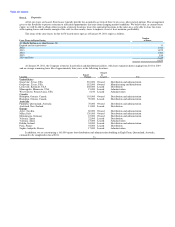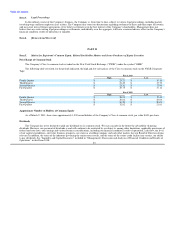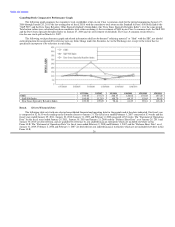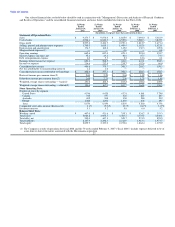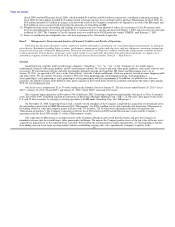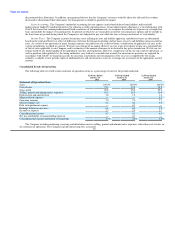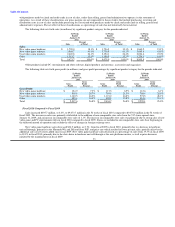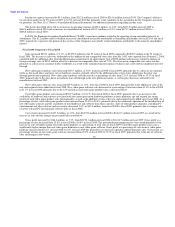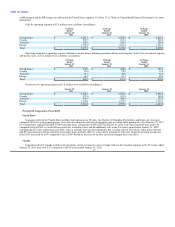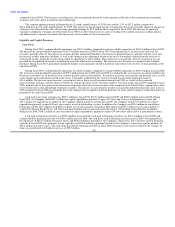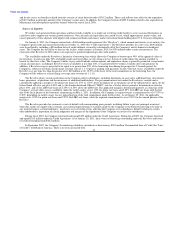GameStop 2010 Annual Report Download - page 47
Download and view the complete annual report
Please find page 47 of the 2010 GameStop annual report below. You can navigate through the pages in the report by either clicking on the pages listed below, or by using the keyword search tool below to find specific information within the annual report.
Table of Contents
cash flows. The impairment testing process is subject to inherent uncertainties and subjectivity, particularly related to sales and gross margin
which can be impacted by various factors including the items listed in Item 1A. Risk Factors. While the fair value is determined based on the
best available information at the time of assessment, any changes in business or economic conditions could materially increase or decrease the
fair value of the reporting unit's net assets and, accordingly, could materially increase or decrease any related impairment charge. Based on
currently available information and forecasts of the Company's annual results, we do not anticipate recording any impairment of goodwill or
other intangible assets in any of the Company's reporting units for the fiscal year ending January 28, 2012.
Other Intangible Assets and Other Noncurrent Assets. Other intangible assets consist primarily of tradenames, leasehold rights,
advertising relationships and amounts attributed to favorable leasehold interests recorded primarily as a result of the Micromania acquisition
and the EB merger. We record intangible assets apart from goodwill if they arise from a contractual right and are capable of being separated
from the entity and sold, transferred, licensed, rented or exchanged individually. The useful life and amortization methodology of intangible
assets are amortized over the period in which they are expected to contribute directly to cash flows.
Tradenames which were recorded as a result of acquisitions, primarily Micromania, are considered indefinite life intangible assets as
they are expected to contribute to cash flows indefinitely and are not subject to amortization, but they are subject to annual impairment testing.
Leasehold rights which were recorded as a result of the Micromania acquisition represent the value of rights of tenancy under commercial
property leases for properties located in France. Rights pertaining to individual leases can be sold by us to a new tenant or recovered by us
from the landlord if the exercise of the automatic right of renewal is refused. Leasehold rights are amortized on a straight-line basis over the
expected lease term not to exceed 20 years with no residual value. Favorable leasehold interests represent the value of the contractual monthly
rental payments that are less than the current market rent at stores acquired as part of the Micromania acquisition or the EB merger. Favorable
leasehold interests are amortized on a straight-line basis over their remaining lease term with no expected residual value. For additional
information related to the Company's intangible assets, see Note 8 of "Notes to Consolidated Financial Statements."
Other non-current assets are made up of deposits and deferred financing fees. The deferred financing fees are associated with the
Company's revolving credit facility and the senior notes issued in October 2005 in connection with the financing of the EB merger. The
deferred financing fees are being amortized over five and seven years to match the terms of the revolving credit facility and the senior notes,
respectively.
Cash Consideration Received from Vendors. The Company and its vendors participate in cooperative advertising programs and other
vendor marketing programs in which the vendors provide the Company with cash consideration in exchange for marketing and advertising the
vendors' products. Our accounting for cooperative advertising arrangements and other vendor marketing programs results in a portion of the
consideration received from our vendors reducing the product costs in inventory. The consideration serving as a reduction in inventory is
recognized in cost of sales as inventory is sold. The amount of vendor allowances recorded as a reduction of inventory is determined by
calculating the ratio of vendor allowances in excess of specific, incremental and identifiable advertising and promotional costs to merchandise
purchases. The Company then applies this ratio to the value of inventory in determining the amount of vendor reimbursements recorded as a
reduction to inventory reflected on the balance sheet. Because of the variability in the timing of our advertising and marketing programs
throughout the year, the Company uses significant estimates in determining the amount of vendor allowances recorded as a reduction of
inventory in interim periods, including estimates of full year vendor allowances, specific, incremental and identifiable advertising and
promotional costs, merchandise purchases and value of inventory. Estimates of full year vendor allowances and the value of inventory are
dependent upon estimates of full year merchandise purchases. Determining the amount of vendor allowances recorded as a reduction of
inventory at the end of the fiscal year no longer requires the use of estimates as all vendor allowances, specific, incremental and identifiable
advertising and promotional costs, merchandise purchases and value of inventory are known.
Although management considers its advertising and marketing programs to be effective, we do not believe that we would be able to
incur the same level of advertising expenditures if the vendors decreased or
31




